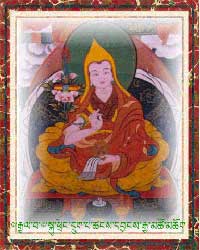
By Vishakha Negi
“The sixth Dalai Lama is beloved by Tibetans,” Eric Mortensen eulogized of Tsangyang Gyatso and his well-known songs. “He’s this lovable, sad beautiful man. He died young, and was a lover and a beautiful poet.”
As associate professor of religious studies at Guilford College, Mortensen has traveled and extensively researched around Asia. His talk, intended primarily for students of Professor Andrew Quintman’s freshman seminar “The Dalai Lama”, was a part of the CEAS Dalai Lama Lecture Series.
Mortensen started off by explaining the circumstances of central and East Asia during the middle ages. The system of patronage established between ruling Mongol princes and Tibetan masters led to the creation of a new, more diplomatic post called the Dalai Lama, or “ocean of wisdom – an intermediary between devotees and the ruling classes.
Tsangyang Gyatso – the sixth incarnation of the Dalai Lama – was lived in present-day Arunachal Pradesh (a state in India) when he was very young. He was to be taken to Potala, where he would supposed to accept his position as Dalai Lama. But when he finally found about more about his job description and all of the restrictions, he panicked and.
“He didn’t want the job,” Mortensen said simply.
But despite his aversion to the monastic lifestyle and the idea of the institution, Tsangyang was destined to save or help the rest of his people and become a true leader.
“He is a sprul sku,” Mortensen wrote the word on the board, “pronounced stul ku. Basically you have one foot in one life and one foot in another – this is the position he is in. Sprul sku are here to help the rest of us.”
Meanwhile, Tsangyang lived up his youth, having amorous relations with many women and writing about his erotic encounters in the form of beautiful poems and songs. But the depth of these songs is fascinating – despite their sweet and sensual lyrics, they speak more to his suppression by the monastic institutions, and have other political undertones, specifically the Mongolian hegemony.
“He grew his hair long, wore turquoise clothing, loved women around Lhasa…even far from Lhasa…He was that guy with the motorcycle jacket.”
These are the very traits that capture the average Tibetan’s imagination – with a spirit of romanticism and freedom from institution and hegemony – and Tsangyang contributed. This was his calling.
Eventually, however, Desi Sangye Gyatso and Tsangyang Gyatso met their ends – the former was beheaded by Mongol associates. The latter was abducted and taken to somewhere northeast towards Mongolia. Though the general consensus seems to be that he was killed, there is still hope that he escaped and lived a fulfilling life elsewhere.
Today, in art, Tsangyang Gyatso is depicted as very Buddha-like – regal and simply-dressed.

“Perhaps this is trying to make up for the ‘institutional disaster’ that he was,” Mortensen explains.
But in the hearts and minds of the Tibetan people, who adore their beloved Dalai Lama with a motorcycle jacket, he was a lover, a poet, and above all, a true human being.
Vishakha Negi is a freshman in Morse college. Contact her at vishakha.negi@yale.edu.